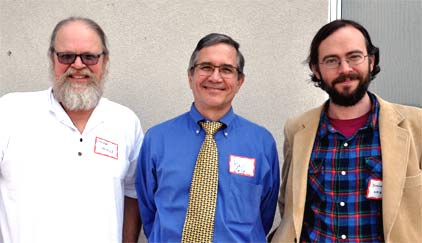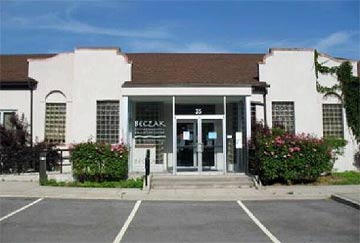
 Scheduled Program
Scheduled Program

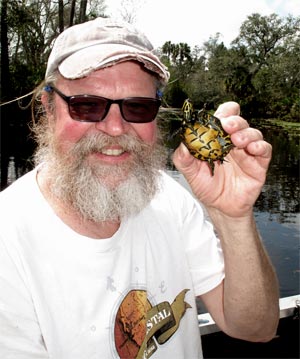

George L. Heinrich with juvenile Suwannee cooter (Pseudemys concinna suwanniensis). Photo by Ernest C. Simmons |

 George L. Heinrich
George L. Heinrich
Heinrich Ecological Services, Florida Turtle Conservation Trust,
St. Petersburg, Florida
 “Understanding the Geographic Distribution of Turtles
“Understanding the Geographic Distribution of Turtles
Is Fundamental to Conservation and Management”
Accurate delineation of any species’ range is vital to assuring appropriate conservation and management efforts. This presentation will review two current distributional surveys of state-listed taxa being conducted in west-central Florida. The first is a biannual gopher tortoise (Gopherus polyphemus) burrow survey of a fragmented population (estimate of 137 tortoises) within a city-owned nature preserve. Data collected is being used to guide upland habitat management efforts and to address concerns regarding minimum viable population and minimum reserve size. The second project is a survey of Florida rivers to determine the southern distribution of the Suwannee cooter (Pseudemys concinna suwanniensis). Restricted to rivers that drain into the northeastern Gulf of Mexico along the northwest coast of Florida, the southern distribution and status of this subspecies is uncertain and hence of conservation concern. Recent fieldwork has documented four new rivers and a range extension. Challenges in the field, museums, and office are more than compensated for by opportunities to drive conservation and experience wild Florida. This program will close with a short overview of the Florida Turtle Conservation Trust’s newest initiative, “The Big Turtle Year” (www.thebigturtleyear.org),
 |

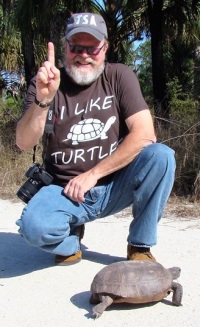
George L. Heinrich with an adult gopher tortoise (Gopherus polyphemus), the first species documented during The Big Turtle Year. Photo by Andrew Farren |
which will be occurring throughout the United States during 2017. Long in the planning, this conservation education project will increase awareness regarding the status of these often overlooked and ecologically significant animals.

George L. Heinrich is a field biologist and environmental educator specializing in Florida reptiles. His company, Heinrich Ecological Services, is based in St. Petersburg, Florida and conducts wildlife surveys and research, natural history programming, and nature-based tours. A graduate of Memphis State University, his interests include southeastern upland, riverine, and brackish wetland ecosystems; conservation challenges facing Florida’s non-marine turtles; and the role of education in conserving herpetofauna. Current collaborative research projects focus on three imperiled species: the gopher tortoise (Gopherus polyphemus), the diamondback terrapin (Malaclemys terrapin), and the Suwannee cooter (Pseudemys concinna suwanniensis). George is an invited member of the IUCN Tortoise and Freshwater Turtle Specialist Group, served twice as co-chair of the Gopher Tortoise Council, and is the executive director of the Florida Turtle Conservation Trust. He has received a number of awards from state and regional NGOs for his conservation and environmental education work, the most recent being from the League of Environmental Educators in Florida—the Golden LEEF Award for Outstanding Contribution to Florida Environmental Education. In June 2009 six NYTTS members joined George’s Florida Turtles Natural History Tour.

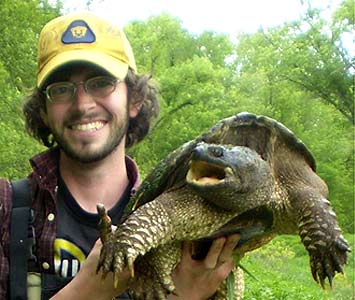

Brendan Reid with snapping turtle |

 Brendan N. Reid
Brendan N. Reid
Postdoctoral Researcher
American Museum of Natural History, New York City
 “Keeping Up with a Changing World,
“Keeping Up with a Changing World,
at a Turtle’s Pace”
For conservation biologists, turtles present a paradox. These unique animals represent one of evolution’s great survivors and have weathered mass extinction events in the past; however, in our current age of global change and biodiversity loss, turtles stand out as one of the most highly threatened vertebrate groups. Understanding how turtles have reacted to recent and historical change in their environment will be crucial
 |
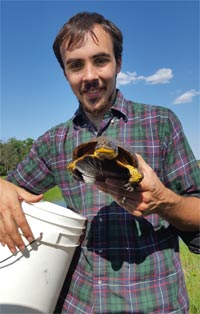
Nathan Byer with Blanding’s turtle |
to preventing the loss of species in the future. In this talk, I will describe several of my research projects, focusing on ongoing field-oriented research on Blanding’s turtles in the Midwest conducted with Nathan Byer, and I will discuss the potential for using information from genomes to determine turtles’ capacity to adapt to ongoing climate change.

Brendan Reid received his Masters degree from Columbia University in 2009. During his time at Columbia, he worked with scientists at the American Museum of Natural History (AMNH) to create a library of genetic barcodes (short segments of DNA that can be used to identify species) for use in the conservation of turtle species. He then conducted PhD research at the University of Wisconsin–Madison, where he focused on the effects of habitat change in the endangered Blanding’s turtle. He completed his doctorate in 2015 and returned to the AMNH for a postdoctoral fellowship. Brendan’s current research uses genomic methods to investigate turtles’ historical responses to changes in climate, as well as their potential to adapt to projected future warming.
Paul P. Calle
WCS Chief Veterinarian and Director of the Zoological Health Program
Wildlife Conservation Society, Bronx Zoo, New York City
 “Yangtze Giant Softshell Turtle (Rafetus swinhoei) Reproduction Update”
“Yangtze Giant Softshell Turtle (Rafetus swinhoei) Reproduction Update”

 |
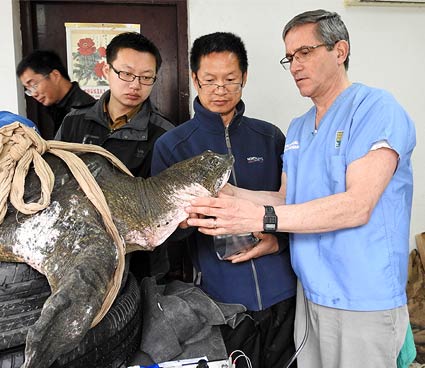

Drs. Paul Calle (right) and Liu Lu Shunqing (center) from the Wildlife Conservation Society examine the sedated male Rafetus during artificial insemination procedures at the Suzhou Zoo.

Photo © Paul P. Calle, WCS |
|
 |
With only three known Yangtze Giant Softshell turtles (Rafetus swinhoei) remaining, two at the Suzhou Zoo in China and one in a lake in Vietnam, the species has the dubious distinction of being the most endangered turtle species on Earth. A conservation effort has been underway since 2008 when the Changsha and Suzhou Zoos, the China Zoo Society, the Turtle Survival Alliance, and the Wildlife Conservation Society (WCS) worked together to move the female from the Changsha Zoo to join the male at the Suzhou Zoo in a last ditch captive breeding effort. Both turtles are estimated to be more than 100 years old, and every year since being united they appeared to engage in normal courtship and copulation with the female regularly laying 2–3 clutches of eggs, numbering over 100, annually. Unfortunately, despite incubation at different temperatures and in different incubation media, including eggs left in the natural nest, none have been fertile. The talk will discuss the history of the collaborative conservation breeding effort for the species, and current artificial insemination efforts.

Paul P. Calle graduated from the University of Pennsylvania School of Veterinary Medicine, completed internships at Manhattan’s Animal Medical Center and the San Diego Zoo, and was the staff veterinarian at the Cheyenne Mountain Zoo. He joined the Wildlife Conservation Society (WCS) in 1989 and is the WCS Chief Veterinarian, Director of the Zoological Health Program, and Vice President for WCS Health Programs. He is based at the Bronx Zoo where he oversees the Clinical, Pathology, and Aquatic Animal Health Departments for WCS’s Zoos and Aquarium and the Wildlife Health Program staff who are based around the world. In addition to administrative responsibilities and medical and surgical care of WCS’s collections, he has participated in local and international field projects in support of WCS’s global conservation mission, including chelonian projects in Russia, China, Vietnam, Cambodia, Myanmar, Belize, Guatemala, and Northeastern U.S. He chairs the WCS Institutional Animal Care and Use Committee (IACUC), is a Diplomate in the American College of Zoological Medicine and the European College of Zoological Medicine (Zoo Health Management), a Professional Fellow of the Association of Zoos and Aquariums (AZA), previous President of the American Association of Zoo Veterinarians (AAZV), committee member of the AZA Animal Health and Field Conservation Committees, and is on the Board of Trustees of Species360. He is a member of the AAZV, the European Association of Zoo and Wildlife Veterinarians, AZA, and the Turtle Survival Alliance.
|
|

|

